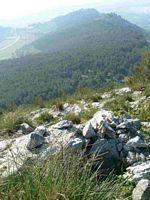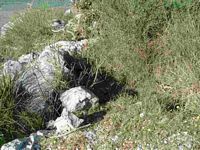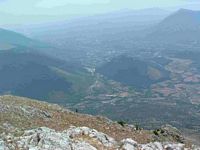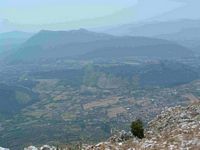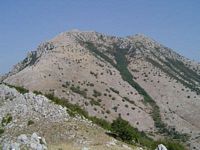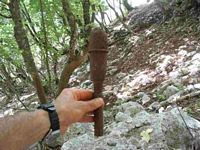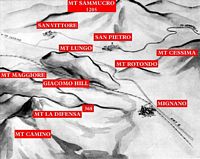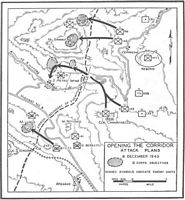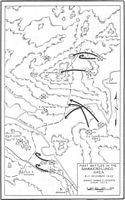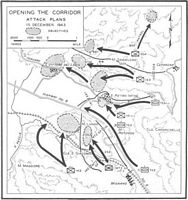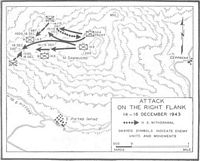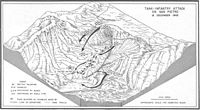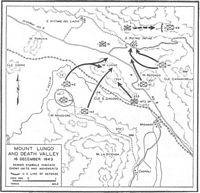Data: 25-09-2005
 Autore: PAOLO FARINOSI
Autore: PAOLO FARINOSI Liste: ARTICLES IN ENGLISH
Liste: ARTICLES IN ENGLISH Categorie: I luoghi
Categorie: I luoghi Tag: huston-john, monte-sammucro, san-pietro-infine
Tag: huston-john, monte-sammucro, san-pietro-infineTHE SENTINELS OF CASSINO
The hold of Mignano has always fascinated me and excited, there is a mountain that belongs to my life since when I had few years:
my father fought there.
Widening my knowledges, almost to stain of oil, I have discovered that Montelungo belonged to a strengthened line, the Bernhard (or Reinhard), that
had been preceded by a pair of others less leathery, and followed by the Gustav, that would sadly have become famous all over the world. I have also
discovered that the Germans put back a lot of hopes in the Bernhard, they counted to stop the allies for longer once of that was in effects, while
they were being fervent without standstill the works to get ready the Gustav, some kilometer behind.
The reason of this optimism is clear visiting the places, only the maps are not enough. The hold of Mignano is defined such since the sides are
guarded by two giants such as the Camino mountain and the Sammucro mountain, from which the territory is dominated for kilometers. The small
Montelungo, just 351 meters high, is a lilliputian to their comparison but its form very lengthened (from which the name) and it’s position,
just between the two sentinels, makes it inexpugnable as long as the defenders will keep the two giants.
Then, because of its morphological conformation it is a true heaven for the one whom defends, a nightmare for the one whom attacks. It is a
disconnected stony slope, with continuous jumps of altitude. Walking is difficult and dangerous; from few centimeters up to half meter high,
it makes you pay dear a loss of equilibrium (personal experience). The Germans, with their usual mastery, got ready postings for single man or
for automatic weapon in neuralgic points (still today well visible) on the various quotas of the mountain, particularly on the tallest. They were
also dug in the rock using explosive, the edges raised again with dry stones, and you could have started keeping silent only with a well centered
hit of artillery (very rare) or at closer distance by hands granades and finally to the white weapon.
The general Clark, commander the Fifth Army, will say subsequently, minimizing the losses:
St. Pietro was the key of the valley of the Liri. We knew it and also the enemy knew it. We had to conquer it, although the immediate cost would have been tall. We succeded, and the cost was not excessive in comparison to the gotten advantages.
So I decided to organize an ascension of the mountain, following the attack guiding lines of the Americans, that were two, one directed against Q. 1205 and one (the Rangers) toward Q. 950. At this point I had a stroke of luck: I would not have been alone, Luigi Grimaldi would have accompanied me. The presence of the experienced Luigi has been fundamental, it has the smell of the find-dog and a considerable preparation as regard to military things, despite his young age.So, in a beautiful and torrid day of end July (2005 ndrs), Luigi and I started our ascent very early in the morning, leaving the village of Ceppagna, sets to the oriental slopes of the Sammucro mountain, just as it made the “A” Company of the American I/143°, that the evening of December 7 th 1943 braved a daring and risky ascension on unknown paths, with objective the tallest top. The gradient is of about 1000 meters, of which only the first 300, 400, are perhaps covered with a thick vegetation; then the ground meets the eye and only in some rare zone, especially in the gully that almost arrives to the top, there is still some vegetation, but I don't believe it was there during the attack, considering the heavy cannonade to which the Americans submitted the mountain in the antecedent days.
The slope is enough steep and the inclination is constant and notable; just at half way, when we arrive on the system of crests towering over St. Pietro valley, the first free view of the inferior battleground, the "death valley", Rotondo Mountain and Montelungo. Comes into view we see Camino mountain, in the background with its last layer, Maggiore mountain, that guards the western side of the narrow passage. But if we turn toward the top that is waiting for us, we realize how audacious was the run chosen by the attackers, the elevated inclination, the indended karst terrain. We try to put us in the boots of those Texan boys that in the dark, in the most total silence, crossed the same paths with knapsacks full of munitions on their shoulders, being careful not to make to slip stones that rolling down, they would have revealed them to the defenders; a thread of anguish attacks us, the more we go up and the harder is the path, the overhanging and threatening top is almost vertical on us. Needles of rock that would have been able to hide each a German posting, oiled barrels ready to shoot rivers of bullets people that they are already busy not to fall down the gullies, just imagine to reply to the enemy’s fire.
We often stop more and more to rest few minutes and a drop of water, the hot persecutes us and in the gully just under the top I find a grenade from American rifle, shortly after I find a big shell splinter from 155, Luigi finds other American splinters. All contributes to let us leave scenes of death again. Near the top, somewhere we have to use our hands, it seems difficult to believe that a whole company has arrived behind the German bunkers taking them by surprise, submerging them by hand bombs and occupyng them with a rush. We wonder how the Germans were caught by surprise; value and cleverness of the Americans are undisputed, but the position is really formidable, it was easy to stop a whole company. The top was garrisoned, even if we don't find a lot holes and bunkers and the hot tempered reaction of the Germans in the hours and in the following days, with huge human costs, it shows how much important was for them its possession. The loss of this position will have certainly caused a bad moment to some young officer commander of platoon or company that had it in the custody. It is not excluded that he lost his life trying to regain it in the following days, livid of anger and shame because of the scoldings of his senior officers. It would be exciting to be able to go down to these levels of knowledge of a battle, individual histories, a man's emotions in front of his probable death, his struggle not to surrender to the fear, to kill not to die.
We finally wander about the cliffs of the top, that it is separated in two and Luigi, as a conjurer, materializes in his hands bullets, rusted rests of boxes of provisions, loaders of the Garand, I find something only after he has individualized a fertile zone, I haven’t the trained eye. The emotion however is great. Those finds are there from more than 60 years to testify something terrible and the today's silence is sharp, it almost bothers, it doesn't help yourself to reconstruct what you have read and that these rusted metallic pieces confirm you it happened really there.
The Americans, after the dirty trick, succeeded in not making themselves dislodge from Q. 1205 but the Germans tried it many times. There were furious assaults both from the western side and from the northern. Two companies of grenadiers attacked from the saddle that divides it from the Q. 950, that had tirelessly been contended by the Rangers and finally conquered; it was a slaughter. We choose just that slope to face the long descent that attends us and we find a steep, rocky endless hillside that leads us under Q. 950; it’s impossible not to think that it was almost a suicidal attack for that brave grenadiers, the Americans were waiting for them. The long and steep ascent is open and the artillery, before the grapeshot, it owes to have made some scary voids. Also here, despite we are thirsty, it is difficult not to be carried away by what we imagine it happened, even if reality will have been well worse.
The Americans, however, did not limite themselves only to keep the possession of the quota, but they also tried to attack in order to advance on the decreasing crests of the mountain evading S. Pietro, directed toward S. Vittore, but the Germans resisted tenaciously and there weren’t significant developments.
We return to Ceppagna in the early afternoon and we go trought the road by car, crossing it leads to S. Pietro. A long, hold and tortuous path that slowly goes down of quota, it’s asphalted now but to that times just more than a mule-track, crossing a pair of kilometers of the length of the mountain before reaching the country. Here some American senior officer commanded an attack of a company of tanks. It was a true idiocy probably sprung by the desperation not to know what to do for breaking the German front, that was bleeding the Division without any significant progress from seven days. The Germans immediately saw the tanks that slowly went down for the harpin bends. They made them approach, someone exploded with the mines, the others were killed with the antitank. Only 4 out of 16 returned back, without result, as logical. Also here I enter into the soldiers, the tankmen in this case, and while I am driving, having their same view, I expect at every moment the shoot that shakes the tank, and pierces the armour-plating and the horrible death that every tankman fears. They knew well how absurd was to attach on a narrow road without possibility to freely drive and with the very problematic support of the infantry (that in effects there was not), but they obeyed as the German grenadiers did, knowing to certainly run towards the death.
On the left, while we are going down, the valley full of terraces and olive-trees (now crossed from the new road that leads to Venafro) it was a death trap for the II and III Battalion, they died among mined fields, explosive traps, the hidden bunkers that crossed in deadly way their fire and the mortars and the artillery shooting with precision when necessary. Today it is also a beautiful landscape, that evokes peace and serenity. How much contrast with those days of December! Then the mockery for all the sacrifices of the 143° on the guiding line S. Pietro-Sammucro (but we must not forget the help given by the paratroops of 504° that had huge losses) it was that the line surrendered mainly because the 16th December fell, thanks to the142°, Maggiore mountain and Montelungo, this one also thanks to the The First Italian Motorized Groupe. So, S. Pietro’s defenders had to withdraw not to end cut out, as it happened with Montecassino few months later. If the Germans had stopped the Americans on the Maggiore mountain as they did on the Sammucro, this battle would still have lasted.
It was an advance of what it would be happened to Cassino, but the Allied headquarters didn’t set great store by it, so they repeted for months frontal attacks against very well armed postings, hoping that terrible bombardments could reduce the enemy defences, instead of trying the outflanking along ways that seemed improbable, but instead they will turn out decisive. Maps:
Nel caso in cui il testo derivi sempicemente dall'esposizione, con o senza traduzione, di documenti/memorie al solo fine di una migliore e più completa fruizione, la definizione Autore si leggerà A cura di.
Articoli associati
FIRST SPECIAL SERVICE FORCE - THE FINAL ADVANCE BEFORE GUSTAV LINE: CERVARO AND MOUNT TROCCHIO
Il resoconto delle operazioni condotte dagli americani nella fase finale dell'avvicinamento alla linea Gustav.
01/02/2004 | richieste: 10066 | VARI
ARTICLES IN ENGLISH | Le battaglie | #gennaio 1944, cervaro, fssf, monte-trocchio, unità-reparti, usa
SAN PIETRO INFINE - 59° ANNIVERSARIO DELLA DISTRUZIONE
Brevi note sulla manifestazione tenuta a ricordo della sanguinosa battaglia per la conquista del paese.
29/12/2002 | richieste: 3982 | ROBERTO MOLLE
Cronache | #today, manifestazioni, san-pietro-infine
LE GROTTE DELLA VALLE DI SAN PIETRO INFINE
I soldati tedeschi erano stati altre volte nel piccolo, antico e arroccato centro di San Pietro Infine, le loro venute erano però amichevoli. Ma da quel fatidico 8 settembre 1943 le cose cambiarono.
31/12/2001 | richieste: 5205 | MAURIZIO ZAMBARDI
La tragedia dei civili | #dicembre 1943, civili, huston-john, san-pietro-infine
SAN PIETRO INFINE - AL DI LÀ DEL FILO SPINATO... PER NON MORIRE DI FAME.
La vicenda di due donne di San Pietro Infine uccise dai tedeschi mentre tentavano di trovare qualche cosa da mangiare.
31/12/2001 | richieste: 4772 | MAURIZIO ZAMBARDI
La tragedia dei civili | #dicembre 1943, civili, san-pietro-infine
SAN PIETRO INFINE - CIVILI UCCISI PER ERRORE NEL DICEMBRE 1943.
Questo è un esempio degli errori che vengono commessi, gioco forza, in guerra: un gruppo di civili di San Pietro Infine viene colpito dal tiro dei cannoni alleati che controllano il paese.
31/12/2001 | richieste: 4411 | MAURIZIO ZAMBARDI
La tragedia dei civili | #dicembre 1943, civili, san-pietro-infine
Nel dicembre 1943 sulla Linea d'Inverno, i tedeschi occupavano le masse montuose del sistema Maggiore-Camino e tutte le montagne che si stendevano verso la catena principale degli Appennini.
03/12/2001 | richieste: 6723 | FRANCESCO ARCESE
Le battaglie | #dicembre 1943, san-pietro-infine
JOHN HUSTON - SAN PIETRO, IL DOCUMENTARIO
Il documentario, del 1943, è relativo alla battaglia di S.Pietro Infine avvenuta nel più ampio scenario della battaglia di Montelungo. Il filmato, girato dal grande regista americano John Huston, viene analizzato in queste pagine tratte da un lavoro di Marco Pellegrinelli.
08/08/2001 | richieste: 6618 | MARCO PELLEGRINELLI
I luoghi | #dicembre 1943, filmografia, huston-john, protagonisti, san-pietro-infine

